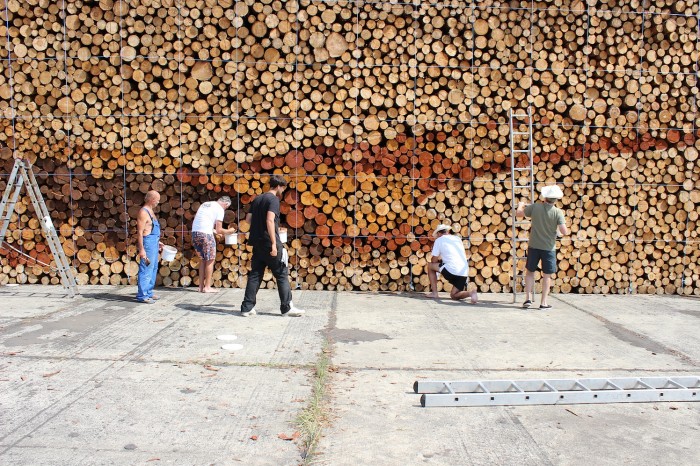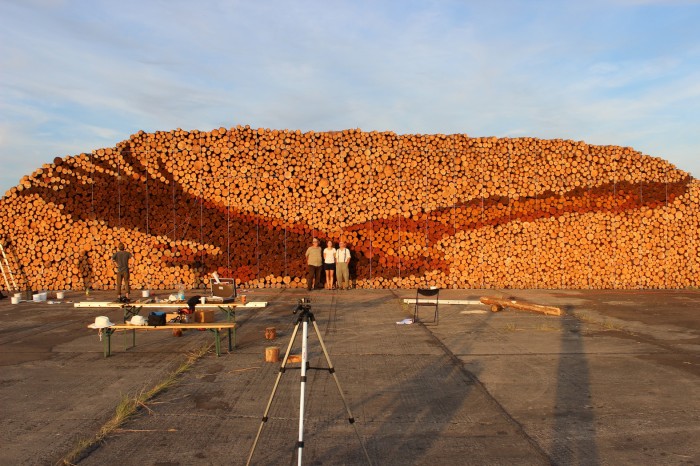Pixel Polter
Pixel Stack
(2013.11.01)
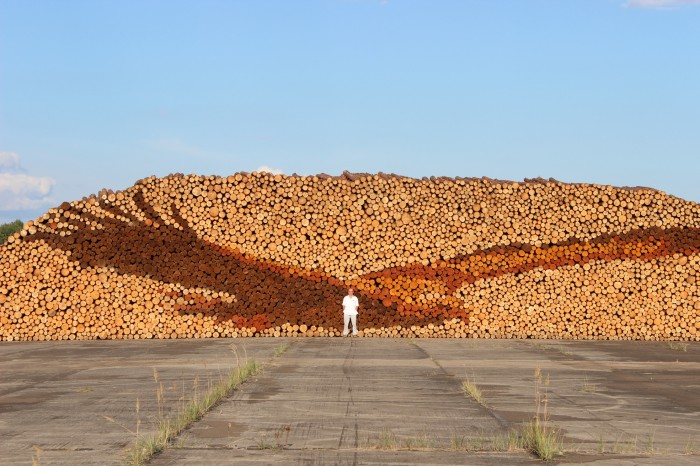
In Kooperation mit dem Landesbetrieb Forst Brandenburg (LFB), mit dem Bundesforstbetrieb Havel-Oder-Spree, der Hatzfeldtschen Forstverwaltung und der HIT Holzindustrie Torgau OHG.
2013 jährte sich die historisch dokumentierte Einführung und Anwendung des Begriffes „Nachhaltigkeit“ zum 300. Mal. Aus diesem Anlass hat Wolfgang Georgsdorf auf Einladung und in Zusammenarbeit mit dem Landesbetrieb Forst Brandenburg, diesmal auch zusammen mit dem Bundesforstbetrieb Havel-Oder-Spree, der Hatzfeldtschen Forstverwaltung, der HIT Holzindustrie Torgau UHG und mit besonderer organisatorischer Unterstützung der Oberförsterei Hammer, das Land-Art-Projekt Pixel Polter konzipiert und realisiert.
Es entstand eine öffentliche Großplastik und Installation in einem bemerkenswerten Teil der Brandenburger Landschaft: Auf dem verlassenen und im Wald versteckten Militärflughafen Löpten bei Hammer (Gemeinde Groß Köris, Landkreis Dahme-Spreewald) wurde ein 35m langer und 6m hoher Polter aus Kiefernstämmen aufgeschichtet („gepoltert“). Die gebeizten Schnittstellen der Stämme bilden die Bildpunkte (Pixel) eines großen Bildes, aus dem aus wachsender Distanz ein eindrucksvolles Gesamtbild entsteht.
300 Jahre Nachhaltigkeit
Das Bildmotiv verweist in mehrerlei Hinsicht auf Idee und Geschichte der Nachhaltigkeit:
Als Gesamtbild besingt es die Rückkehr und Zunahme der Arten (diese Region hat zum Beispiel inzwischen die größte Seeadlerdichte Europas). Des Weiteren nimmt es als ein durch dieses Gesamtbild stilisiertes Diagramm der historischen Abnahme und, nach 1713 mit dem nachfolgenden Greifen der Nachhaltigkeitsidee, wiederum der Zunahme nachwachsenden Waldes in Deutschland Bezug zur Idee der Nachhaltigkeit. Außerdem verweist es auf die Rückeroberung eines Militärflughafens durch den Flugverkehr von Tieren, und schließlich auf das Phänomen, dass eine große Idee – insbesondere die der Nachhaltigkeit – erst aus größerer zeitlicher oder räumlicher Entfernung sichtbar wird.
Random Pixeling
Die Systeme der digitalen Bilderstellung wurden jüngst um das Prinzip des „Random Pixeling“ erweitert, mit dem zur Vermeidung von Darstellungsproblemen der bisher gerasterten, regelmäßigen Anordnung von Bildpunkten (Pixeln) nunmehr eine absichtlich zufällige Anordnung dieser Bildpunkte angewendet wird. Die Installation Pixel Polter erweitert dieses Prinzip und treibt es zu einem Extrem: Hier ist nicht mehr nur die Anordnung der Bildpunkte zufällig, sondern auch deren Dimension und Form, die sich aus den verschieden großen Baumstämmen ergibt.

Credits:
Konzept und Realisation:
Wolfgang Georgsdorf
Produktionsassistenz:
Claudio Thamm
Computersimulation und Ausführungsplanung in Digitalgrafik:
Noah Nixon
Assistenz vor Ort:
Claudio Thamm
Felix Volz
Paul Volz
Ausführungshelfer vor Ort:
Willi Schwabe
Peter Macky
Gereon von Haimberger
Ross Healy
Jo Gould
Terry Gould
Beratung bei der Pixelkorrektur und Umsetzung am Objekt:
Georg Ritter
Hanna Piksarv
Kooperationspartner:
Landesbetrieb Forst Brandenburg
Bundesforstbetrieb Havel-Oder-Spree
Hatzfeldtsche Forstverwaltung
HIT Holzindustrie Torgau OHG
Holzfäller:
Lutz Demmler
Stapelung des Polters:
Michael Drechsler
Assistenz Dokumentation:
Claudio Thamm
Felix Volz
Paul Volz
Dank an:
Peter Macky / Kaiserbahnhof Halbe
Noah Nixon
Tim Ness
Oberförsterei Hammer
Reinhard Geister
Georg Ritter
Ernst Fischer
Jürgen Rose
Dirk Busch
Mark Magdon
Wolfgang Janka
Peter Brune
Inge Volz
2011 marks the 300th anniversary of the introduction and appliance of the term „sustainability“ in Germany. On this occasion, Wolfgang Georgsdorf drafted and carried out the land-art-project Pixel Polter in cooperation with the Brandenburg State Forest Holding (LFB) and the Federal German Forest Administration, this time also together with the Hatzfeld Forest Administration, the HIT-Timber Industry Torgau and with special support of Oberförsterei Hammer (headquarters of forest district Hammer).
A public installation in the midst of an impressive landscape in Brandenburg’s countryside: On the abandoned military airfield Löpten, hidden inside the forest and near the headquarters of the forest district Hammer (municipality Groß Köris, district Dahme-Spreewald), a 35m long and 6m high stack of timber was piled up.
The stained cut surfaces of the logs form the image points (pixels) of a big image which can be seen from a growing distance. Pixel Polter is yet another cooperation between the Brandenburg State Forest Holding (LFB)/ Oberfoersterei Hammer and Wolfgang Georgsdorf. It combines several aspects regarding to content and aesthetics:
300 years sustainability
The image is a reference to the idea and history of sustainability in various aspects:
Generally it points out the return and the increase of species (e.g. this region by now has the highest density of sea eagles in Europe). Furthermore it is a stylised diagram of the historical decrease after 1713, the following grasp of the idea of sustainability and again the increase of regrowing forest in Germany. Also, it shows the recapture of a military airfield by birds and finally it alludes to the phenomenon that a great idea like the idea of sustainability is only visible with time and distance, especially regarding to its implementation
Random Pixeling
The systems of digital image-creation were recently broadened by the principle of “Random Pixeling”. A deliberately accidental order of image points (pixels) is used to avoid representation problems of the up to now rasterised, regular order of pixels. The installation Pixel Polter expands this principle and takes it to an extreme: here, not only the pixels are random, but also their dimension and form which result from the different sizes of the logs. Yet viewed from a distance, the image is sharp.
Credits:
Artwork / concept and realisation:
Wolfgang Georgsdorf
Personal assistance:
Claudio Thamm
Computer simulation und detailed digital design:
Noah Nixon
Assistance on site:
Claudio Thamm
Felix Volz
Paul Volz
Hands and helpers in accomplishment:
Willi Schwabe
Peter Macky
Gereon von Haimberger
Ross Healy
Jo Gould
Terry Gould
Consulting in pixel correction and implementation on site:
Georg Ritter
Hanna Piksarv
Partners of cooperation:
Landesbetrieb Forst Brandenburg
Bundesforstbetrieb Havel-Oder-Spree
Hatzfeldtsche Forstverwaltung
HIT Holzindustrie Torgau
Feller:
Lutz Demmler
Stacker:
Michael Drechsler
Assistance documentation:
Claudio Thamm
Felix Volz
Paul Volz
Thanks to:
Peter Macky / Kaiserbahnhof Halbe
Noah Nixon
Tim Ness
Oberförsterei Hammer
Reinhard Geister
Georg Ritter
Ernst Fischer
Jürgen Rose
Dirk Busch
Mark Magdon
Wolfgang Janka
Peter Brune
Inge Volz
This project was conducted in cooperation with the Brandenburg State Forest Holding (LFB), the Federal German Forest Administration and the HIT Holzindustrie Torgau OHG.
![]()
![]()
![]()
![]()
![]()
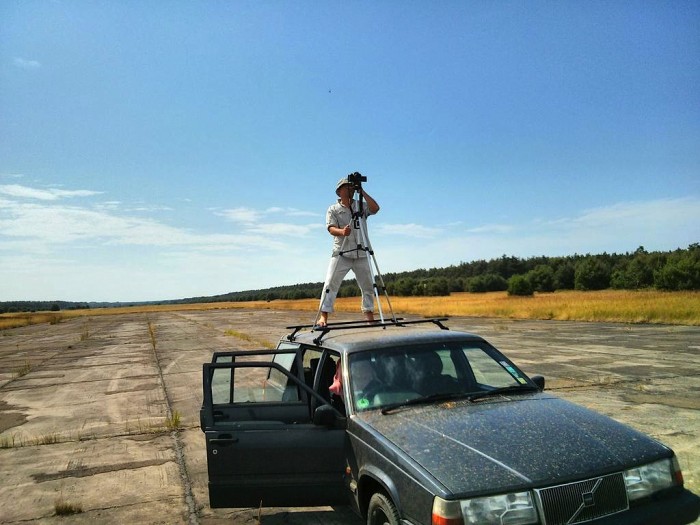
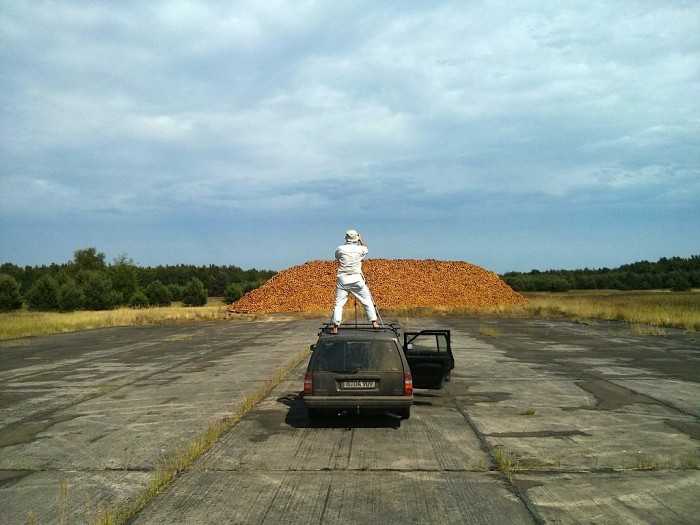

![]()
![]()


